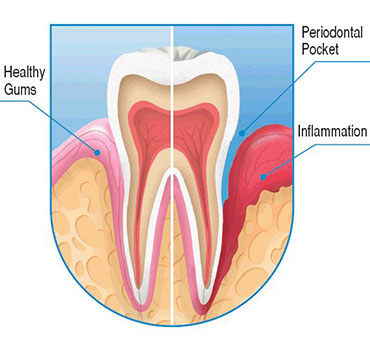Gum Problem

Periodontal disease commonly called Gum Disease, caused due to bacterial attacks in your gums. This causes inflammation, bone loss, and finally tooth loss. Generally, it is difficult for common people recognize periodontal problems. Habits like smoking, chewing tobacco, and drinking may also cause this disease.
Some of the symptoms of periodontal disease are bad breath, caused due to sulfur compounds formed by harmful bacteria, bleeding gums, redness and swelling in the gums, and sensitivity. All these are caused due to several factors giving rise to dental plaque, these factors are, food lodgement, improper shape and size of teeth, breathing through the mouth, nutrition and food habits, etc.
Periodontal disease starts with gingivitis, which is a bacterial infection causing inflammation in the gum tissues. If ignored, this may lead to Periodontitis, which causes bone loss in the teeth surroundings. Since the bone tissue is lost, the gums and teeth start separating, giving rise to pockets where bacteria start developing. This will ultimately cause tooth loss, pain and inflammation.
Everyone who does not practice daily oral hygiene eventually develop periodontal problems. The best way to take care about this is by brushing and flossing regularly. Visiting dentists for regular dental examinations or cleaning is also good to avoid these problems. Your dentist will help you remove plaque and tartar using special tools. The best way to control gum problems is to evaluate your oral hygiene techniques.
Treatments for gum disease
Once a patient is diagnosed with gum (periodontal) disease, dentists will use procedures other than regular cleaning (also called prophylaxis) to treat the disease. In the early stages of gum disease, most treatment involves non-surgical procedures; however, in more advanced stages, surgical procedures are often required. The following are detailed descriptions of these procedures.
Non-surgical procedures
1. Scaling and root planing:While a regular dental cleaning is for the visible portion of teeth, scaling and root planing is a special cleaning that removes plaque and tartar (also known as calculus) from under the gumline (in periodontal pockets) and smoothes the root surfaces to promote healing. A scaling procedure is the only way to remove calculus from this area.
In some cases, antibiotics or antimicrobials may be used to supplement the effects of scaling and root planing. In most cases of early gum disease, scaling and root planing in addition to continued daily cleaning at home will achieve a satisfactory result of reversing gum disease.
2. Periodontal maintenance/supportive periodontal therapy:Following a scaling and root planing, specialized deep cleanings can minimize the recurrence or progression of gum disease.
Surgical procedures
1. Pocket depth reduction procedures:Your dentist will open up the affected gum tissue so that disease-causing bacteria and calculus build-up can be removed. Some cases may require smoothing and recontouring the damaged bone and root surfaces to allow the gum tissue to reattach to healthy bone during healing. The procedure also repositions the gum tissue so that it is easier to keep clean.
2. Regeneration:Your dentist will treat the affected gum tissue in the same way as in pocket depth reduction procedures, with the additional procedure of using membranes, bone grafts or tissue-stimulating proteins to stimulate the body's natural ability to regenerate healthy bone and gum tissue.
3. Soft tissue grafts:Your dentist will take healthy gum tissue from the roof of the mouth (palate) or other areas of the mouth and use it to repair receding gums and cover exposed root surfaces.
At Krishna Dental Care, we offer utmost care to your gums and teeth, starting from cleaning, polishing in case of preliminary stages to periodontal bone grafting and tissue regeneration in case of advanced stage. As we know prevention is better than cure, so start the habit of brushing and flossing daily, twice a day to save your gums.
